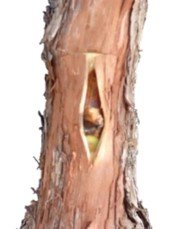Grafting on site is probably the most qualitative method but it is also the most time-consuming because the rootstocks must be planted on-site first and can only be manually grafted once they are sufficiently developed. This generally delays the return to production by 2 years. But in the long term, recent studies show that the Esca-affected vine rate remains below 1%. This benefits vineyard sustainability and makes the older vines economically viable. Another advantage is that it encourages strong root development before the vine becomes productive.
1.4.4.b On-site grafting
What are existing techniques for on-site grafting?
- Chip-bud grafting
The bud of the scion is placed at rootstalk level where the bark has been removed beforehand. A highly technical procedure, it is important to remove no more wood from the rootstalk than the size of the scion to prevent any necrosis. This can take place from early spring to early summer. A sap-pulling branch should be kept to avoid blocking sap flow and ensure the rootstalk's survival in case the scion is non-viable. If the graft fails, it will be possible to start again the following year.
- T-bud graft
A graft type that allows the best contact between the rootstock and scion. There is no necrosis with this method since it does not touch the xylem but simply cuts into the bark to place the graft on the cambium of the rootstock. It must be done at a moment when there is intense sap flow, such as during flowering. Therefore, it is only effective if done during the 15 days of flowering, which is also the principle downside of this method.


